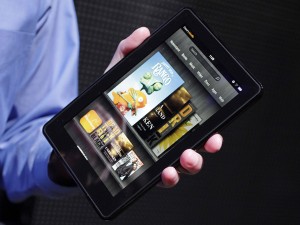
CHALLENGE TO iPAD The Kindle Fire is shown at a news conference on Sept. 28, 2011, in New York. The e-reader and tablet has a 7-inch (17.78 cm) multicolor touchscreen and will go on sale for $199 on Nov. 15. AP photo/Mark Lennihan
Days after its unveiling last week, the 7-inch Kindle Fire is now being touted by some as the tablet that can challenge the Apple iPad’s reign in the tablet market.
It is, after all, priced at a very affordable $199. Its size also makes it more portable and easier to use with just one hand. Despite its limited 8GB storage, users can avail themselves of unlimited storage in the Amazon cloud for apps bought from Amazon AppStore.
Still, obviously, it is no iPad. It has neither 3G nor Bluetooth connectivity. It has no apps for producing content, and has neither camera nor microphone.
But then, the Kindle Fire is targeted at a different audience, according to technology research firm Gartner Inc.
“It’s focused on content consumption. We doubt that consumers wanting a tablet for communication or productivity will be tempted,” Gartner said in a report released September 30. “We expect Amazon to launch a 10-inch tablet in 2012 that will compete more directly with Apple.”
Given the specifications of Kindle Fire, it does look to be geared more at users who want to consume content rather than produce it. It may not be as loaded as the iPad when it comes to features, but it does have aces up its sleeve.
For its sub-$200 price tag, the Kindle Fire’s dual-core processor, in-plane switching screen, and Gorilla Glass—the same tough glass used in higher-priced tablets, PCs, and smartphones—are quite a steal, Gartner said.
The research firm said these features alone should challenge other tablet manufacturers to come up with something special to get users to buy their wares at prices higher than the Kindle Fire’s $199.
Apart from having a possibly lasting impact on tablet prices, Gartner said the Kindle Fire could also further drive cloud service adoption.
“Amazon built the Kindle Fire around its cloud services—video, books, apps, music, Web services, computing and storage. The (user interface) is content-centric, and the internal storage serves as cache for offline use—the user’s content synchs wirelessly as needed,” Gartner said.
Research firm International Data Corp. (IDC), which still categorized the Kindle Fire as an e-reader, said shipments should grow significantly in the remaining part of the year, particularly during the holidays.
In the second quarter, Amazon held the lion’s share of the market at 51.7 percent, followed by Barnes & Noble, which had a 21.2-percent share of the pie. A total of 5.4 million units were shipped globally during that time.
For the entire year, e-reader shipments should reach as many as 27 million units, a significant increase from IDC’s earlier projection of 16.2 million units.
“E-readers are also gaining traction with a combination of increasing function and affordability, as well as greater device and content availability. The strong first-half performance and an improved view of e-reader positioning helped boost our outlook for shipment volume,” Worldwide Trackers research analyst Jennifer Song said.
The Kindle Fire hits stores on November 15 in the United States.